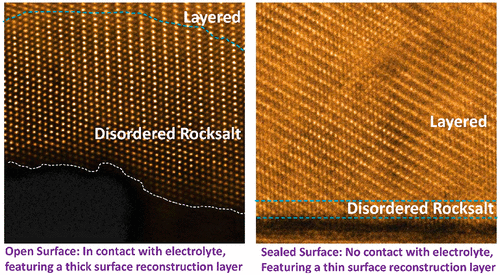当前位置:
X-MOL 学术
›
Chem. Mater.
›
论文详情
Our official English website, www.x-mol.net, welcomes your feedback! (Note: you will need to create a separate account there.)
The Role of Secondary Particle Structures in Surface Phase Transitions of Ni-Rich Cathodes
Chemistry of Materials ( IF 8.6 ) Pub Date : 2020-03-30 , DOI: 10.1021/acs.chemmater.9b04938 Lianfeng Zou 1 , Wengao Zhao 2 , Haiping Jia 2 , Jianming Zheng 2 , Linze Li 1 , Daniel P. Abraham 3 , Guoying Chen 4 , Jason R. Croy 3 , Ji-Guang Zhang 2 , Chongmin Wang 1
Chemistry of Materials ( IF 8.6 ) Pub Date : 2020-03-30 , DOI: 10.1021/acs.chemmater.9b04938 Lianfeng Zou 1 , Wengao Zhao 2 , Haiping Jia 2 , Jianming Zheng 2 , Linze Li 1 , Daniel P. Abraham 3 , Guoying Chen 4 , Jason R. Croy 3 , Ji-Guang Zhang 2 , Chongmin Wang 1
Affiliation

|
Nanometer-thick reconstruction layers on layered cathode surfaces have been widely observed on both pristine and cycled materials. However, the mechanisms of reconstruction and the role that these structures play in electrochemical performance are not fully understood. From a crystallographic perspective, such surface reconstruction layers result from cation site-mixing between Li and transition-metal ions, but it remains far from clear as to what the critical factors are that control such cation mixing for various cathode chemistries. Here, we report observations on surface transformations during cycling of a Ni-rich cathode-oxide that are governed by direct contact with the liquid electrolyte. Specifically, within a secondary particle, the three-dimensional hierarchical aggregate of primary particles leads to the formation of grain boundaries of different characteristics, including open grain boundaries that allow the permeation of liquid electrolyte, and closed grain boundaries that exclude liquid electrolyte penetration. Upon battery cycling, surfaces in direct contact with the liquid electrolyte showed a surface reconstruction layer while the surfaces that did not have contact with the electrolyte showed no such reconstructions. In addition, the critical role of oxygen in reconstruction of grain boundaries is demonstrated, and the unexpected oxygen depletion at twin boundaries result in severe phase transitions. The present work provides further insights into phase transitions at solid–solid and solid–liquid interfaces within secondary cathode particles and suggests strategies for mitigating surface/interfacial degradation.
中文翻译:

次级粒子结构在富镍阴极表面相变中的作用
在原始材料和循环材料上都广泛观察到分层阴极表面上的纳米级重建层。但是,还没有完全理解重建的机理以及这些结构在电化学性能中的作用。从晶体学的角度来看,这种表面重建层是由Li和过渡金属离子之间的阳离子位点混合产生的,但是对于控制各种阴极化学性质的阳离子混合的关键因素尚不清楚。在这里,我们报告了富镍阴极氧化物循环过程中表面转变的观察结果,该转变受与液体电解质直接接触的控制。具体来说,在次级粒子内,一次颗粒的三维分层聚集体导致形成具有不同特征的晶界,包括允许液体电解质渗透的开放晶界和排除液体电解质渗透的闭合晶界。在电池循环时,与液体电解质直接接触的表面显示出表面重建层,而未与电解质接触的表面没有显示出这种重建。另外,证明了氧在晶界重构中的关键作用,并且在双晶界的意外氧耗竭导致严重的相变。
更新日期:2020-04-23
中文翻译:

次级粒子结构在富镍阴极表面相变中的作用
在原始材料和循环材料上都广泛观察到分层阴极表面上的纳米级重建层。但是,还没有完全理解重建的机理以及这些结构在电化学性能中的作用。从晶体学的角度来看,这种表面重建层是由Li和过渡金属离子之间的阳离子位点混合产生的,但是对于控制各种阴极化学性质的阳离子混合的关键因素尚不清楚。在这里,我们报告了富镍阴极氧化物循环过程中表面转变的观察结果,该转变受与液体电解质直接接触的控制。具体来说,在次级粒子内,一次颗粒的三维分层聚集体导致形成具有不同特征的晶界,包括允许液体电解质渗透的开放晶界和排除液体电解质渗透的闭合晶界。在电池循环时,与液体电解质直接接触的表面显示出表面重建层,而未与电解质接触的表面没有显示出这种重建。另外,证明了氧在晶界重构中的关键作用,并且在双晶界的意外氧耗竭导致严重的相变。



























 京公网安备 11010802027423号
京公网安备 11010802027423号